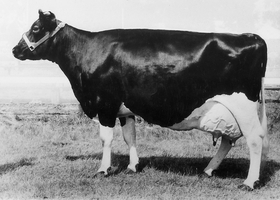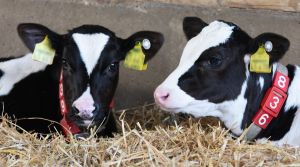Over 140 years of German Holstein breeding - How it all began

The old black and white coloured breed is one of the co-founders of today's high-milking Holstein Friesian breed.
In Germany, the first official breeding cooperative was founded in Fischbeck in the Altmark in 1876. The aim was to use purebred sires of the black and white lowland breed
and thus to develop this breed in a pure-bred state. From this point on, the number of regional breeders' associations and breeding cooperatives grew constantly, only to regroup into larger organisations in later years. To this date, many influential cow families have survived, whose bloodlines can be traced back to the first registrations in the herd books of Northern Germany.
In most breeding organisations, black and white and red and white animals were initially kept in the same herd book and the breeding goal for both colour varieties was identical. In later times, breeding associations were founded that were only responsible for black and white or red and white coloured animals.
The work of the breeding associations was severely compromised by the world wars. However, thanks to the commitment of passionate breeders, the herdbook societies resumed their work over and over again, thus ensuring the continuity of the German Holstein breed and its qualities. This development took place in parallel in West Germany and East Germany.
In the middle of the 1960s, the cooperation between breeding organisations and semen collection centres intensified in order to ensure further breeding progress. This structural development continued, so that bigger and bigger breeding organisations grew up. After reunification, cattle breeding in the new federal states also followed this strategy. In the meantime, the breeding goals between German Holsteins and Red Holsteins had moved so much in the same direction that in 1996 a joint breeding goal was set for both breeds.
The genomic age
The decoding of the bovine genome in 2004 opened up new possibilities for Holstein breeding. The continuous improvement of molecular genetic methods led to an inexpensive new selection method, the genotyping of cattle. Markers, in this case the so-called SNP (Single Nucleotide Polymorphism), can be linked to trait expressions. This makes it possible to predict the performance potential of cattle with the help of genetic information.
In order to further improve the reliability of genomic breeding values, a common training set was formed at the European level under the name EuroGenomics. With more than 43,000 bulls, it is the largest training set in the world and represents the entire European and North American Holstein population.
However, as the information content of the bull training set was also reaching it's limits, the idea of setting up a female training set was initiated. Here, the large contract herds in Eastern Germany pioneered the development of the cow training set (KuhL) from 20,000 randomly selected cows. Based on this, an even larger female training set was started in 2016 with the nationwide KuhVision project, which today includes about 250,000 calved cows. These projects were also the basis for the introduction of genomic health breeding values, enabled by the additional recording of diseases by farmers. The project was so popular among breeders that the breeding organisations additionally offered pure herd genotyping (without additional data collection), so that today about 20% of herdbook cows are genomically tested. Other countries such as Luxembourg or Austria are also participating in KuhVision.











